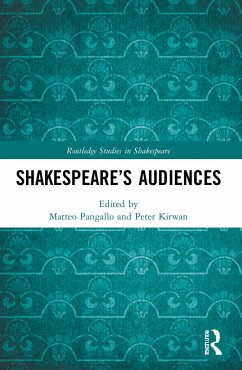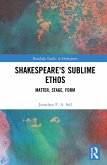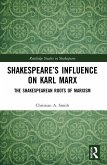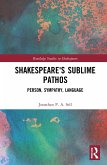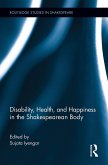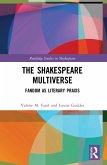Shakespeare's Audiences
Herausgeber: Pangallo, Matteo; Kirwan, Peter
Shakespeare's Audiences
Herausgeber: Pangallo, Matteo; Kirwan, Peter
- Broschiertes Buch
- Merkliste
- Auf die Merkliste
- Bewerten Bewerten
- Teilen
- Produkt teilen
- Produkterinnerung
- Produkterinnerung
The essays in this collection use a variety of methods and approaches to explore the global history of audience experience of Shakespearean performance in theater, film, radio, and digital media.
Andere Kunden interessierten sich auch für
![Shakespeare's Sublime Ethos Shakespeare's Sublime Ethos]() Jonathan P. A. SellShakespeare's Sublime Ethos41,99 €
Jonathan P. A. SellShakespeare's Sublime Ethos41,99 €![The Routledge Handbook of Shakespeare and Animals The Routledge Handbook of Shakespeare and Animals]() The Routledge Handbook of Shakespeare and Animals47,99 €
The Routledge Handbook of Shakespeare and Animals47,99 €![The Media Student's Book The Media Student's Book]() Gill Branston (UK Cardiff University)The Media Student's Book87,99 €
Gill Branston (UK Cardiff University)The Media Student's Book87,99 €![Shakespeare's Influence on Karl Marx Shakespeare's Influence on Karl Marx]() Christian A. SmithShakespeare's Influence on Karl Marx59,99 €
Christian A. SmithShakespeare's Influence on Karl Marx59,99 €![Shakespeare's Sublime Pathos Shakespeare's Sublime Pathos]() Jonathan P. A. SellShakespeare's Sublime Pathos41,99 €
Jonathan P. A. SellShakespeare's Sublime Pathos41,99 €![Disability, Health, and Happiness in the Shakespearean Body Disability, Health, and Happiness in the Shakespearean Body]() Disability, Health, and Happiness in the Shakespearean Body46,99 €
Disability, Health, and Happiness in the Shakespearean Body46,99 €![The Shakespeare Multiverse The Shakespeare Multiverse]() Valerie M. FazelThe Shakespeare Multiverse45,99 €
Valerie M. FazelThe Shakespeare Multiverse45,99 €-
-
-
The essays in this collection use a variety of methods and approaches to explore the global history of audience experience of Shakespearean performance in theater, film, radio, and digital media.
Produktdetails
- Produktdetails
- Routledge Studies in Shakespeare
- Verlag: Taylor & Francis Ltd
- Seitenzahl: 250
- Erscheinungstermin: 26. September 2022
- Englisch
- Abmessung: 229mm x 152mm x 14mm
- Gewicht: 370g
- ISBN-13: 9780367715489
- ISBN-10: 0367715481
- Artikelnr.: 65611627
- Herstellerkennzeichnung
- Libri GmbH
- Europaallee 1
- 36244 Bad Hersfeld
- gpsr@libri.de
- Routledge Studies in Shakespeare
- Verlag: Taylor & Francis Ltd
- Seitenzahl: 250
- Erscheinungstermin: 26. September 2022
- Englisch
- Abmessung: 229mm x 152mm x 14mm
- Gewicht: 370g
- ISBN-13: 9780367715489
- ISBN-10: 0367715481
- Artikelnr.: 65611627
- Herstellerkennzeichnung
- Libri GmbH
- Europaallee 1
- 36244 Bad Hersfeld
- gpsr@libri.de
Matteo Pangallo is an Assistant Professor of English at Virginia Commonwealth University. Peter Kirwan is Associate Professor of Early Modern Drama at the University of Nottingham.
Matteo Pangallo and Peter Kirwan, "Introduction."
Embodied Audiences
1. Stephanie Shirilan, "Respiratory Sympathy and Pneumatic Community in
Shakespeare."
2. Joe Falocco, "Recovering the Humoral Body through Original Practice
Performance."
3. Jennifer A. Low, "Haptic Experience and Fluid Boundaries: Macbeth
and Czech Nationalism at ¿eský Krumlov's Revolving Theater."
Constructing Audiences
4. Romola Nuttall, "The most lamentable Romaine Tragedie of Titus
Andronicus and Audiences from the Inns of Court."
5. Miles Drawdy, "'Cleave the General Ear': Shakespeare and the Cultural
Bias of Early American Radio."
6. Koel Chatterjee, "Indian Shakespeare Cinema and the Active Audience."
7. Pascale Aebischer, "Gender, Aura, and the Close-Up: Broadcasting
Shakespeare for Female Audiences."
Performing Audiences
8. Edel Lamb, "Shakespeare's Riotous Audiences: Macbeth at Astor Place,
1849."
9. Adam Sheaffer, "'How novelty may move': Play and the Boundaries of
the Play in the New York Shakespeare Festival's Mobile Theatre."
10. Louise Geddes, "Imagined Theater: Why Fan Audiences Matter."
Observing Audiences
11. Valerie M. Fazel, "'A vulgar comment will be made of it': YouTube and
Robert Weimann's Platea."
12. Rachael Nicholas, "Shakespeare's Digital School Audience: Agency and
Control in the Reception of an RSC Schools' Broadcast."
13. Emily Lathrop, "For Everybody: Casting, Race, and Audience Engagement
in The Public Theater's Mobile Unit."
Embodied Audiences
1. Stephanie Shirilan, "Respiratory Sympathy and Pneumatic Community in
Shakespeare."
2. Joe Falocco, "Recovering the Humoral Body through Original Practice
Performance."
3. Jennifer A. Low, "Haptic Experience and Fluid Boundaries: Macbeth
and Czech Nationalism at ¿eský Krumlov's Revolving Theater."
Constructing Audiences
4. Romola Nuttall, "The most lamentable Romaine Tragedie of Titus
Andronicus and Audiences from the Inns of Court."
5. Miles Drawdy, "'Cleave the General Ear': Shakespeare and the Cultural
Bias of Early American Radio."
6. Koel Chatterjee, "Indian Shakespeare Cinema and the Active Audience."
7. Pascale Aebischer, "Gender, Aura, and the Close-Up: Broadcasting
Shakespeare for Female Audiences."
Performing Audiences
8. Edel Lamb, "Shakespeare's Riotous Audiences: Macbeth at Astor Place,
1849."
9. Adam Sheaffer, "'How novelty may move': Play and the Boundaries of
the Play in the New York Shakespeare Festival's Mobile Theatre."
10. Louise Geddes, "Imagined Theater: Why Fan Audiences Matter."
Observing Audiences
11. Valerie M. Fazel, "'A vulgar comment will be made of it': YouTube and
Robert Weimann's Platea."
12. Rachael Nicholas, "Shakespeare's Digital School Audience: Agency and
Control in the Reception of an RSC Schools' Broadcast."
13. Emily Lathrop, "For Everybody: Casting, Race, and Audience Engagement
in The Public Theater's Mobile Unit."
Matteo Pangallo and Peter Kirwan, "Introduction."
Embodied Audiences
1. Stephanie Shirilan, "Respiratory Sympathy and Pneumatic Community in
Shakespeare."
2. Joe Falocco, "Recovering the Humoral Body through Original Practice
Performance."
3. Jennifer A. Low, "Haptic Experience and Fluid Boundaries: Macbeth
and Czech Nationalism at ¿eský Krumlov's Revolving Theater."
Constructing Audiences
4. Romola Nuttall, "The most lamentable Romaine Tragedie of Titus
Andronicus and Audiences from the Inns of Court."
5. Miles Drawdy, "'Cleave the General Ear': Shakespeare and the Cultural
Bias of Early American Radio."
6. Koel Chatterjee, "Indian Shakespeare Cinema and the Active Audience."
7. Pascale Aebischer, "Gender, Aura, and the Close-Up: Broadcasting
Shakespeare for Female Audiences."
Performing Audiences
8. Edel Lamb, "Shakespeare's Riotous Audiences: Macbeth at Astor Place,
1849."
9. Adam Sheaffer, "'How novelty may move': Play and the Boundaries of
the Play in the New York Shakespeare Festival's Mobile Theatre."
10. Louise Geddes, "Imagined Theater: Why Fan Audiences Matter."
Observing Audiences
11. Valerie M. Fazel, "'A vulgar comment will be made of it': YouTube and
Robert Weimann's Platea."
12. Rachael Nicholas, "Shakespeare's Digital School Audience: Agency and
Control in the Reception of an RSC Schools' Broadcast."
13. Emily Lathrop, "For Everybody: Casting, Race, and Audience Engagement
in The Public Theater's Mobile Unit."
Embodied Audiences
1. Stephanie Shirilan, "Respiratory Sympathy and Pneumatic Community in
Shakespeare."
2. Joe Falocco, "Recovering the Humoral Body through Original Practice
Performance."
3. Jennifer A. Low, "Haptic Experience and Fluid Boundaries: Macbeth
and Czech Nationalism at ¿eský Krumlov's Revolving Theater."
Constructing Audiences
4. Romola Nuttall, "The most lamentable Romaine Tragedie of Titus
Andronicus and Audiences from the Inns of Court."
5. Miles Drawdy, "'Cleave the General Ear': Shakespeare and the Cultural
Bias of Early American Radio."
6. Koel Chatterjee, "Indian Shakespeare Cinema and the Active Audience."
7. Pascale Aebischer, "Gender, Aura, and the Close-Up: Broadcasting
Shakespeare for Female Audiences."
Performing Audiences
8. Edel Lamb, "Shakespeare's Riotous Audiences: Macbeth at Astor Place,
1849."
9. Adam Sheaffer, "'How novelty may move': Play and the Boundaries of
the Play in the New York Shakespeare Festival's Mobile Theatre."
10. Louise Geddes, "Imagined Theater: Why Fan Audiences Matter."
Observing Audiences
11. Valerie M. Fazel, "'A vulgar comment will be made of it': YouTube and
Robert Weimann's Platea."
12. Rachael Nicholas, "Shakespeare's Digital School Audience: Agency and
Control in the Reception of an RSC Schools' Broadcast."
13. Emily Lathrop, "For Everybody: Casting, Race, and Audience Engagement
in The Public Theater's Mobile Unit."

